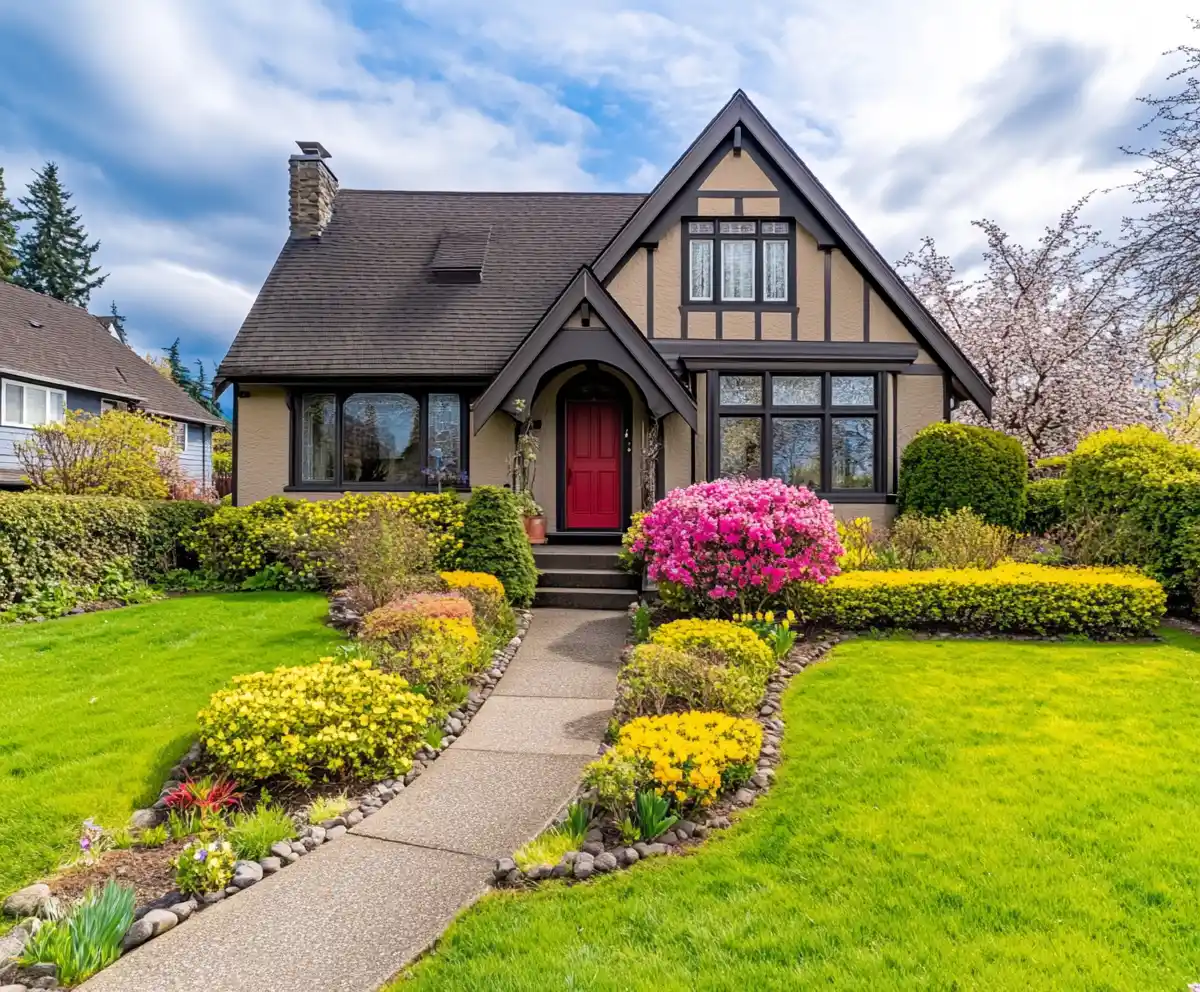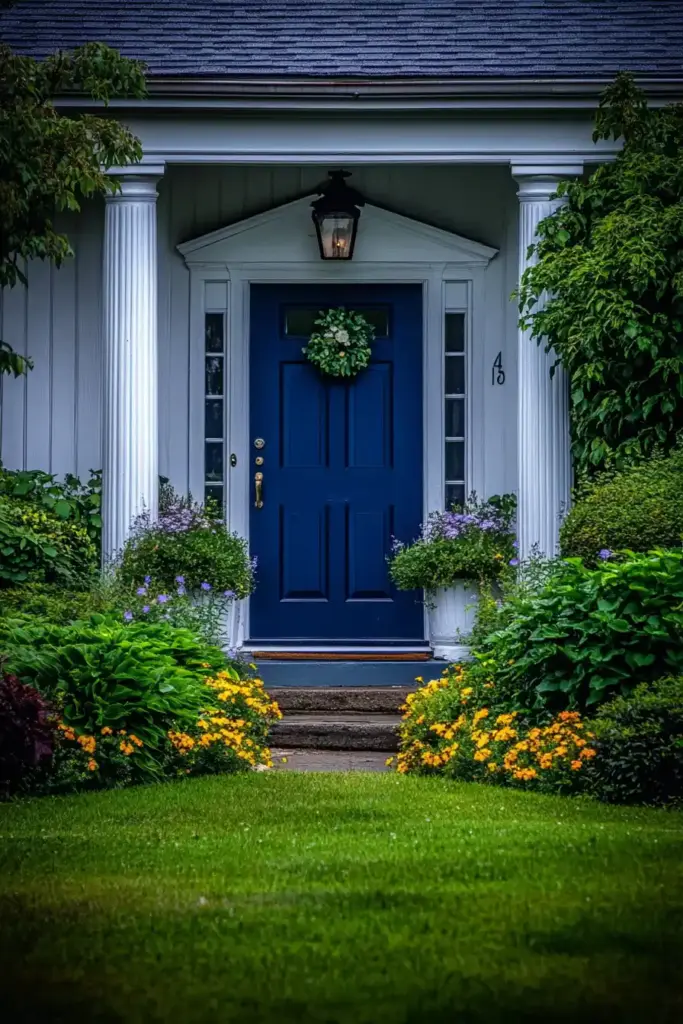When it comes to boosting curb appeal, front yard landscaping ideas can make all the difference. Whether you’re aiming for a cozy cottage feel or a sleek modern vibe, the right design choices bring unity, beauty, and a welcoming atmosphere to your home’s exterior. Great landscaping blends proportion, balance, unity, and variety — creating a harmonious space that reflects your personal style while complementing the architecture of your house.
Before you dive into planning, a few essentials can set your project up for success. Start by choosing plants that thrive in your climate and soil. Pay close attention to plant tags, which offer guidance on light and watering needs. Incorporate evergreens to ensure year-round structure, and don’t forget the power of edging — it keeps garden beds looking neat and well-defined. Smart pruning will maintain the health and beauty of your landscape for seasons to come.
12 Front Yard Landscaping Ideas to Inspire Your Next Project
When it comes to personalizing your front yard, there are endless ways to combine beauty and function. These creative landscaping ideas will help you craft a yard that feels both welcoming and polished — starting right at your front door.
1. Flower Beds and Foundation Plants
Nothing says “welcome home” quite like colorful flower beds and lush foundation plantings. Here’s how to make the most of them:
- Compact Beds for Small Homes: Small front yards benefit from tight, well-designed planting beds that don’t overwhelm the space. Choose low-growing flowers and shrubs to keep the focus neat and charming.
- Tall Plants for Two-Story Homes: Larger homes need more visual weight at the base. Incorporate taller shrubs, ornamental trees, and layered plantings to balance the height of your house.
- Mulch or Groundcover Finishing Touches: A tidy finish makes all the difference. Use mulch to retain moisture and suppress weeds, or opt for creeping groundcovers like thyme or sedum for a soft, natural look.
Pro Tip: Group plants with similar water and light needs together to make care easier and your beds healthier.
2. Formal Front Landscaping
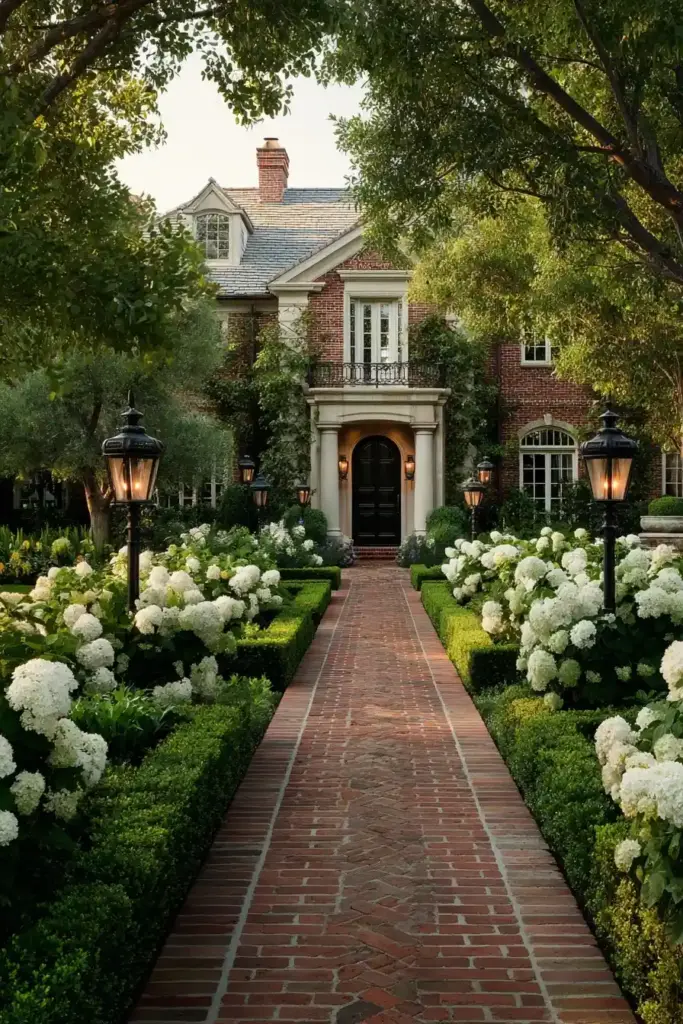
If you love order, symmetry, and a classic look, formal front yard landscaping could be your perfect match. This timeless style creates a polished, elegant entrance that never goes out of fashion.
- Symmetrical Layouts: Balance is key. Mirror your plantings on either side of walkways or the front door for a stately, structured appearance.
- Limited Plant Variety: Stick to just a few types of plants for a clean and cohesive look. Think clipped boxwoods, hydrangeas, and white roses.
- White Flowers and Trimmed Hedges: White blooms and neatly trimmed hedges add sophistication and keep the color palette crisp and classic.
- Brick Paths and Classic Materials: Traditional materials like brick, stone, and wrought iron complement formal gardens beautifully, reinforcing the structured feel.
Pro Tip: Formal gardens require regular maintenance, but the payoff is a front yard that’s always photo-ready and stunning.
3. Modern Front Yard Landscaping
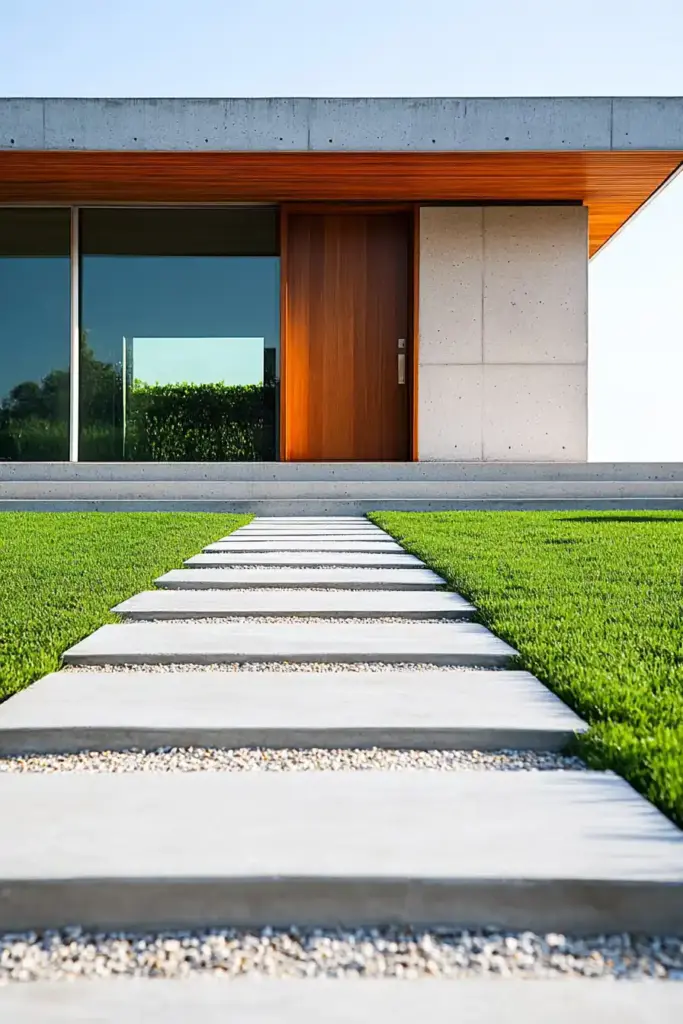
If sleek lines, simplicity, and minimalism speak to your style, modern front yard landscaping could be the perfect fit. This design approach focuses on clean aesthetics and easy maintenance, without sacrificing curb appeal.
- Embrace Clean Lines: Modern landscapes favor sharp, geometric shapes. Use straight-edged garden beds, squared-off pathways, and crisp lawn borders to create a sharp look.
- Low-Growing Plants: Choose plants that stay low and neat, like succulents, ornamental grasses, or dwarf shrubs, to maintain an uncluttered vibe.
- Gravel and Concrete Pavers: Swap traditional lawns for gravel areas or stepping-stone pavers set in minimalist patterns for a contemporary touch.
- Minimalistic Color Palette: Stick to a limited range of colors — often greens, whites, and muted tones — to keep the landscape feeling serene and polished.
Pro Tip: Lighting is essential in modern designs. Consider installing sleek, low-profile landscape lights to highlight pathways and architectural features after dark.
4. Cottage Gardens
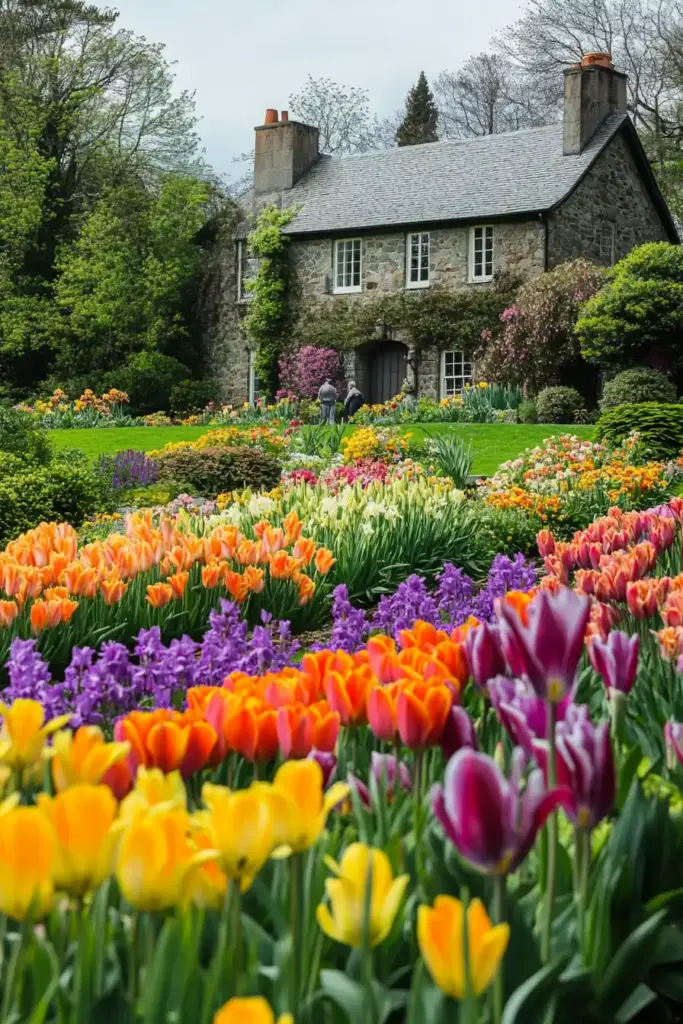
Dreaming of a whimsical, overflowing front yard that feels like a secret garden? Cottage garden landscaping brings charm, color, and personality right to your doorstep with its lush and informal style.
- Dense, Colorful Plantings: Pack your garden with a variety of flowers, herbs, and shrubs. Think roses, foxgloves, lavender, and daisies all mingling together in beautiful chaos.
- Local and Native Plants: Native species thrive with less effort and blend seamlessly into a natural, wildflower look.
- Trellises and Picket Fences: Add vertical interest and old-world charm with trellises for climbing roses or classic white picket fences framing your yard.
- Curving Walkways: Ditch the straight lines! Winding stone paths or gravel walkways add to the relaxed, storybook feel.
- Regular Maintenance Required: Cottage gardens are enchanting but not low-maintenance. Expect to spend time deadheading flowers, pruning shrubs, and keeping the growth under control.
Pro Tip: Embrace organized chaos — layer plants of varying heights and textures for a lush, abundant look without losing visual flow.
5. Container Gardens
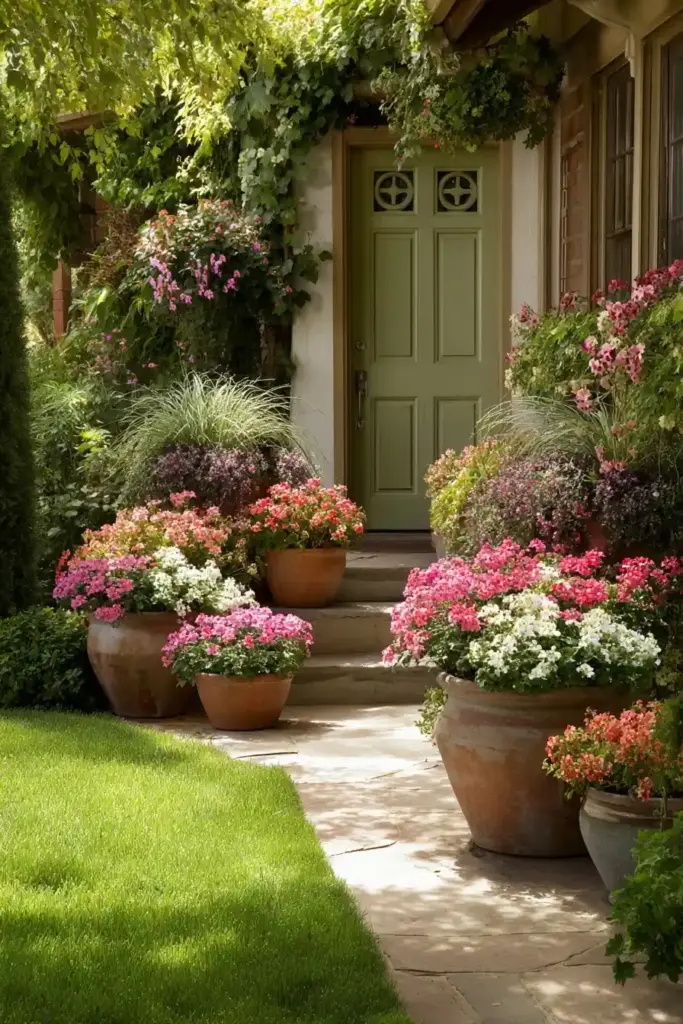
Short on space or just love the flexibility to refresh your look with the seasons? Container gardens are a fantastic way to add vibrant greenery and colorful blooms to your front yard without the commitment of in-ground planting.
- Perfect for Renters and Small Spaces: Containers let you garden without digging up the yard — ideal for patios, entryways, and porches.
- Easy to Swap and Rearrange: Want a fall display of mums or a summer burst of petunias? With pots, it’s easy to change your plants with the seasons or your mood.
- Play with Heights and Colors: Mix tall plants like ornamental grasses with trailing flowers such as petunias or ivy to create eye-catching layers.
- Choose the Right Pots: Terracotta, glazed ceramic, metal, or even lightweight resin pots add personality. Just make sure containers have good drainage.
- Low Maintenance: Potted plants are easier to manage — simply group those with similar sunlight and watering needs together for easy care.
Pro Tip: Place large containers symmetrically on either side of your front steps or entryway for a polished, welcoming entrance.
6. Hardscaping for Structure and Style
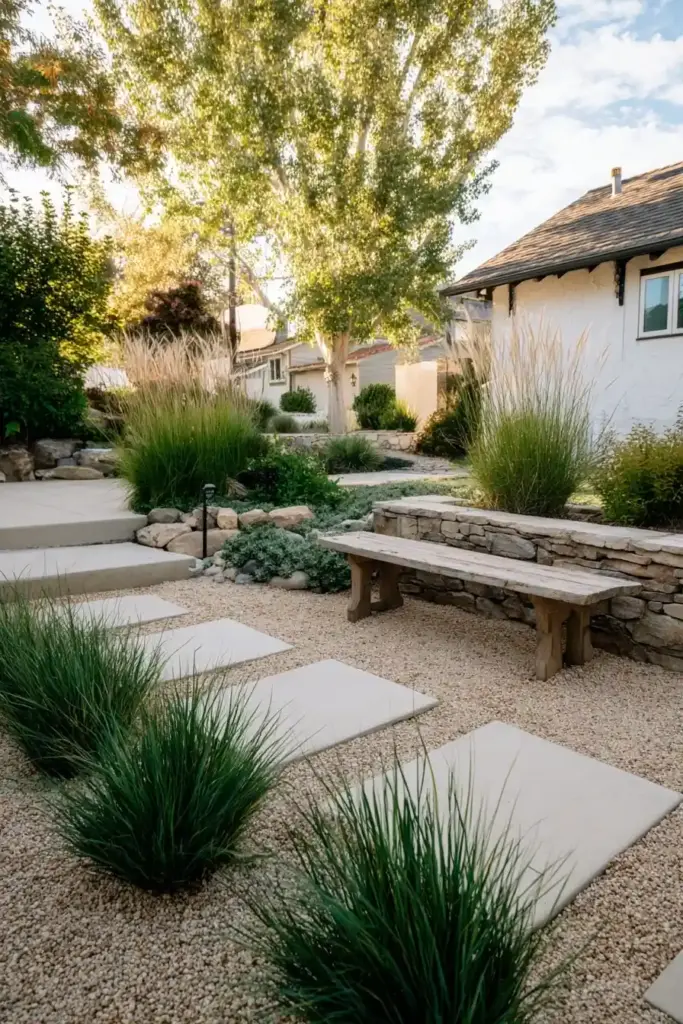
Hardscaping adds texture, structure, and durability to your front yard, making your landscaping not only beautiful but also highly functional. It’s the perfect partner to soft, leafy plantings.
- Incorporate Stone and Pavers: Natural stone walkways, concrete stepping stones, or decorative gravel paths add visual interest and guide visitors through your yard.
- Define Spaces: Use retaining walls, patios, or raised beds to break up large open spaces and create distinct areas for planting or relaxing.
- Low-Maintenance Appeal: Unlike lawns and flower beds, hardscapes require very little upkeep — no mowing, watering, or fertilizing needed!
- Visual Balance: Combining hard surfaces with soft greenery prevents your yard from feeling too harsh or sterile.
- Eco-Friendly Options: Permeable pavers and gravel can help rainwater filter into the ground, reducing runoff and helping the environment.
Pro Tip: Blend hardscape elements with plants — like lining a stone path with ornamental grasses — to soften the look and make it feel more natural.
7. Small Front Yard Ideas
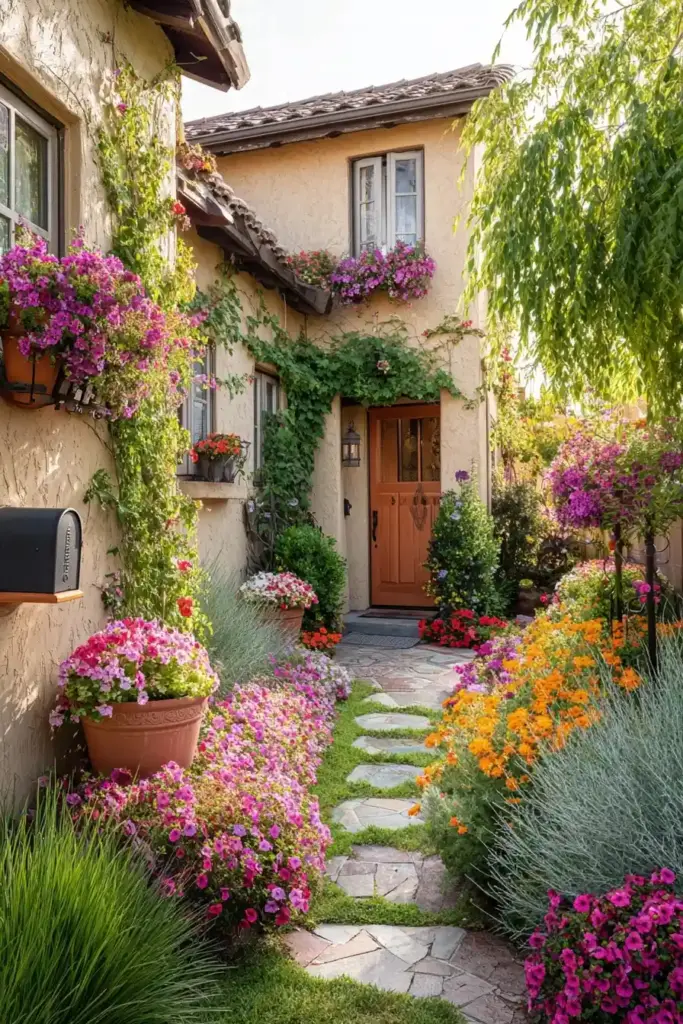
A modest-sized front yard doesn’t mean you have to compromise on style or impact. With smart design choices, small spaces can feel just as grand and welcoming as larger ones.
- Plant Around Mailboxes: Dress up your mailbox by planting colorful flowers, low-growing shrubs, or ornamental grasses at its base.
- Use Containers and Window Boxes: Containers aren’t just for patios — they’re perfect for adding pops of color on stairs, porches, and walkways. Window boxes bring vibrant life to your home’s facade.
- Try Vertical Gardening: Maximize space by going up instead of out. Trellises, wall planters, and hanging baskets let you enjoy more greenery without taking up valuable ground space.
- Creative Hardscape Solutions: Use narrow walkways, stepping stones, or a small patio area to add structure without overwhelming the space.
Pro Tip: Stick to a tight color palette and repeat key plants to make a small yard feel more unified and spacious.
8. Terracing for Sloped Front Yards
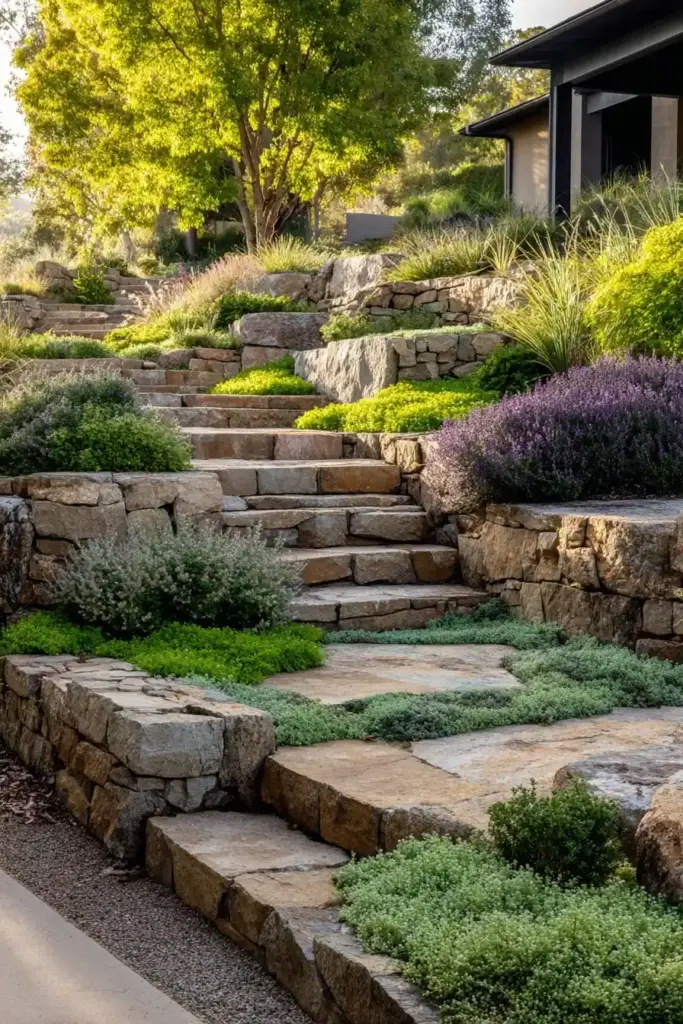
If your front yard has a slope, terracing is a smart (and beautiful) solution. Not only does it create usable planting spaces, but it also helps prevent erosion and adds tons of curb appeal.
- Use Retaining Walls: Build low, sturdy retaining walls with natural stone, concrete blocks, or timber to carve your slope into multiple flat levels.
- Groundcovers for Erosion Control: Plant hardy groundcovers like creeping thyme, sedum, or vinca minor to stabilize the soil and add greenery between terraces.
- Create Garden Beds on Each Level: Turn each terrace into its own mini-garden, using different plant heights, colors, and textures for visual interest.
- Add Steps or Pathways: Integrate stone or gravel steps between levels to make your landscape functional and inviting.
Pro Tip: Keep drainage in mind when building terraces. Proper grading and drainage solutions will ensure your beautiful landscape lasts for years without water damage.
9. Drought-Tolerant Front Yard Ideas
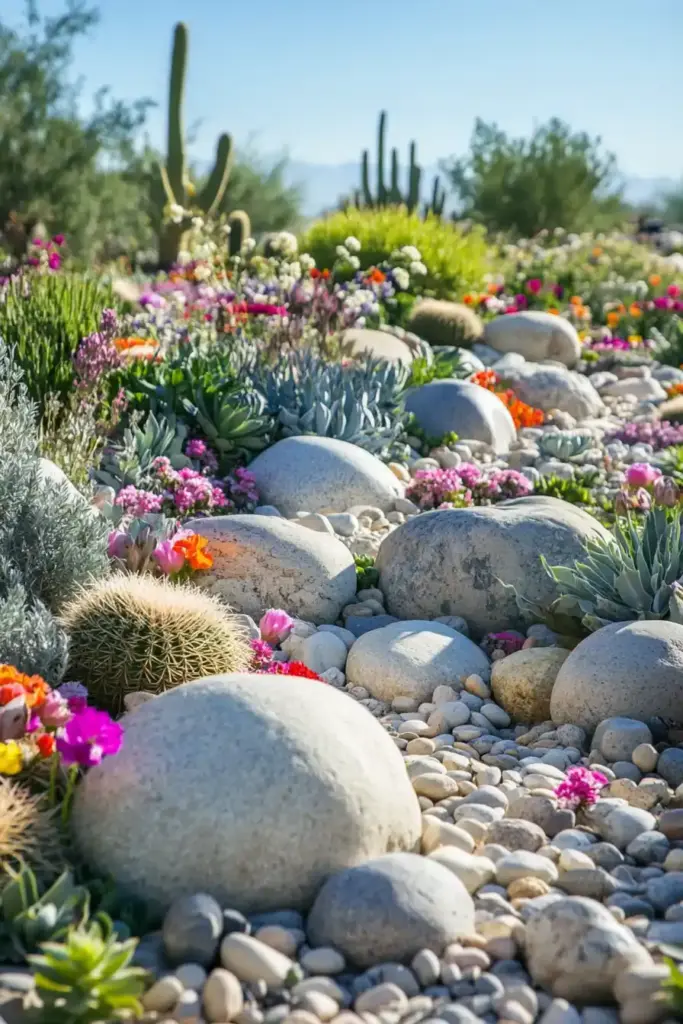
Saving water doesn’t mean sacrificing style. Drought-tolerant landscaping — also called xeriscaping — combines beauty and sustainability, making it perfect for dry climates or anyone looking to cut down on watering.
- Plant Succulents and Drought-Resistant Species: Choose hardy plants like agave, sedum, lavender, and thyme that thrive with minimal water.
- Replace Lawns with Rock Gardens or Hardscapes: Traditional grass can be a water guzzler. Swap it out for gravel beds, stone features, or artificial turf to create a low-maintenance, stylish space.
- Use Mulch Generously: A thick layer of mulch around plants helps retain soil moisture, suppress weeds, and regulate soil temperature.
- Group Plants by Water Needs: Place thirsty plants closer to water sources and drought-tolerant ones farther out to simplify irrigation.
Pro Tip: Adding a drip irrigation system ensures your plants get just the right amount of water without waste — perfect for sustainable front yard landscaping.
10. Low-Maintenance Modern Front Yard Landscaping
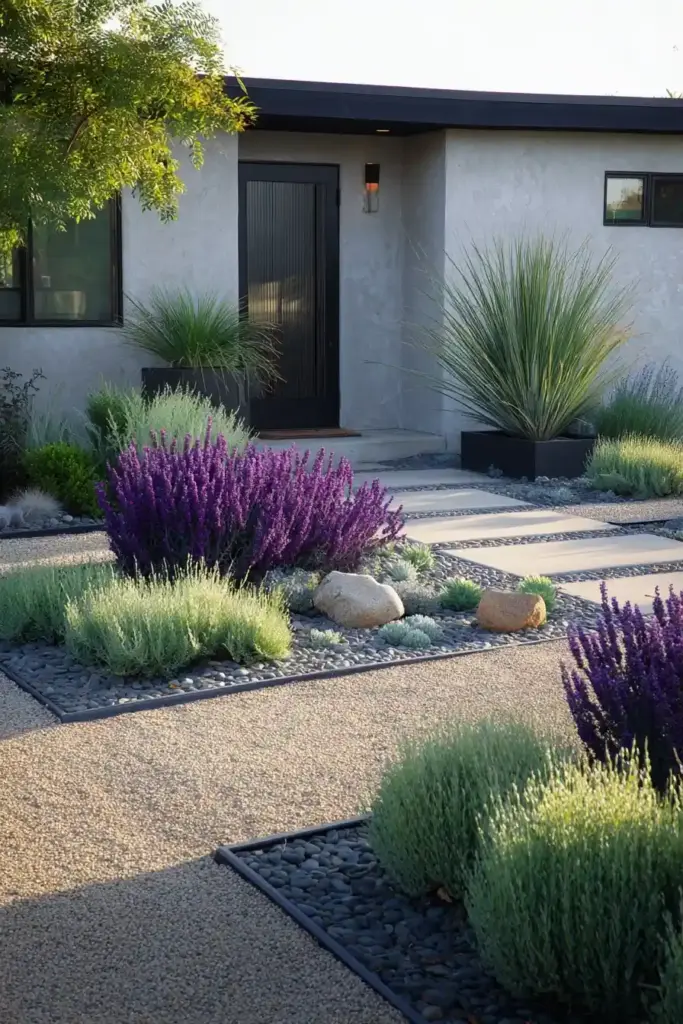
Want a front yard that looks amazing without spending your weekends on upkeep? Low-maintenance modern landscaping focuses on simplicity, structure, and easy-care plants for effortless curb appeal.
- Container Gardens for Flexibility: Stylish pots filled with low-water plants like succulents or grasses add greenery without overwhelming maintenance needs.
- Gravel Paths and Beds: Swap high-maintenance lawns for decorative gravel or crushed stone walkways that stay neat and stylish all year long.
- Symmetrical Layouts: Simple, balanced designs not only look modern but are also easier to care for. Fewer plants and clear borders mean less weeding and pruning.
- Choose Drought-Tolerant, Easy-Care Plants: Think ornamental grasses, lavender, yarrow, and compact evergreens that thrive with minimal watering and fuss.
Pro Tip: Plan your front yard layout with long-term growth in mind. Select slow-growing plants that won’t need constant trimming to maintain their sleek shapes.
11. Fence Line Landscaping
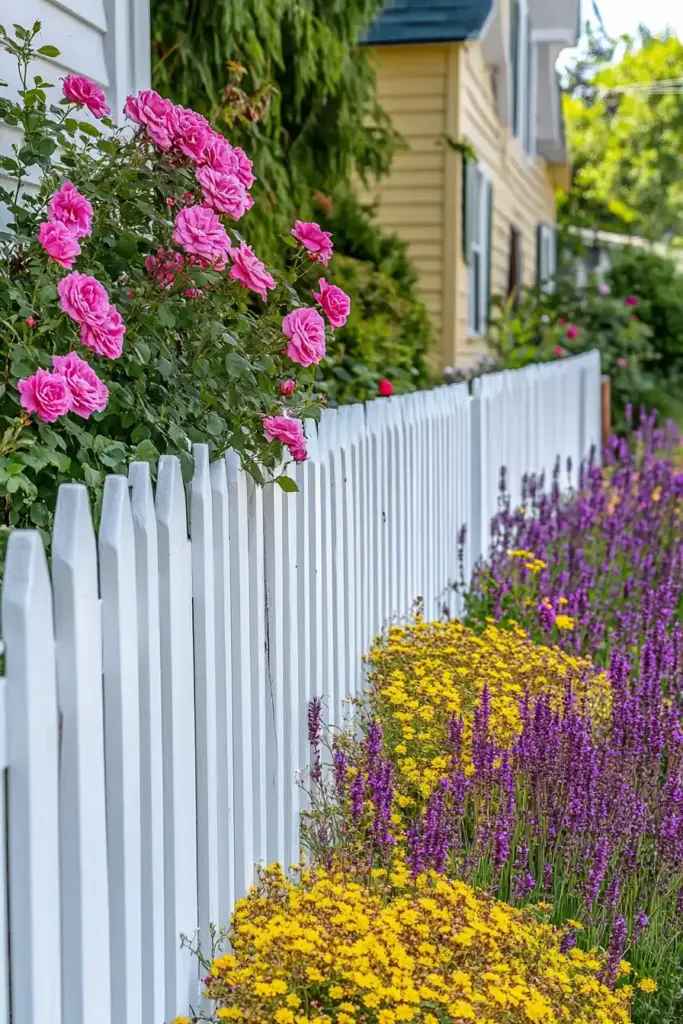
Don’t let your fence line be an afterthought! With a little creativity, you can turn this boundary into a beautiful focal point that frames your front yard perfectly.
- Grow Climbing Plants: Add vertical beauty with flowering vines like clematis, climbing roses, or jasmine. They soften hard fences and add bursts of color and fragrance.
- Create Planting Beds Along the Fence: Layer shrubs, perennials, and groundcovers along the fence to create depth and visual interest.
- Plant a Living Hedge: Swap a standard fence for a natural green wall using hedges like boxwood, holly, or privet.
- Incorporate Decorative Gravel or Mulch: Define planting areas and keep weeds down by adding a clean layer of mulch or gravel around the base of plants.
Pro Tip: Choose plants that match the sun exposure along your fence — a shady north-facing fence will need different species than a sun-soaked southern one.
12. A Front Yard Pond for Serenity and Beauty
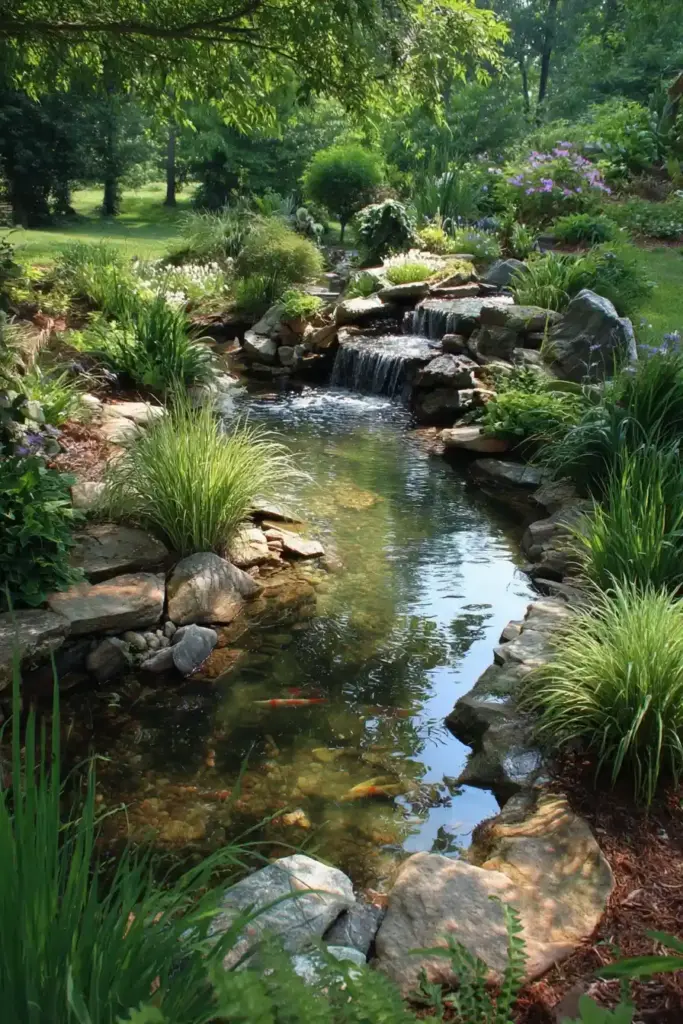
Want to add a touch of magic to your front yard landscaping ideas? A small pond or water feature can completely transform your outdoor space, bringing movement, sound, and even wildlife into your landscape.
- Install a Small Pond or Water Garden: Even a modest pond can have a big impact. Surround it with rocks, aquatic plants, and maybe even a few goldfish for extra charm.
- Use Waterfalls or Fountains: Moving water creates soothing sounds that mask street noise and add a sense of calm and luxury to your yard.
- Surround with Lush Plantings: Frame your pond with grasses, ferns, and blooming perennials to create a natural, organic look.
- Invite Wildlife: Birds, butterflies, and frogs are naturally drawn to water, adding an extra layer of life and vibrancy to your landscape.
Pro Tip: Choose a location that gets a mix of sun and shade to keep your pond healthy and your aquatic plants thriving.
Additional Front Yard Landscaping Tips
Want to take your front yard landscaping ideas even further? These extra tips will help you add those special touches that make your yard truly unforgettable.
- Plant More Natives: Native plants aren’t just easy to care for — they also support local wildlife like bees, butterflies, and birds.
- Add Architectural Features: Think beyond plants! Arbors, trellises, benches, and pergolas add structure and create cozy, inviting spaces.
- Install Landscape Lighting: Showcase your favorite plants, trees, and pathways at night with soft, warm lighting. Solar-powered options make it easy and energy-efficient.
- Include Ornamental Grasses: These low-maintenance beauties add movement, texture, and a natural feel to your design.
- Set Up Drip Irrigation: Save water and make plant care easier by installing a drip system that delivers moisture directly to roots, where it’s needed most.
Pro Tip: Even small upgrades — like swapping out an old porch light for a stylish fixture — can make a huge difference in the overall look of your front yard.
Front Yard Landscaping FAQs
Still have questions about creating your dream front yard? Here are answers to some of the most common landscaping questions homeowners have:
How can I make my front yard look amazing?
Focus on combining a variety of textures, colors, and shapes while keeping a balanced overall design. Layering plants of different heights, adding architectural features like paths or arbors, and using a consistent color scheme will instantly elevate your front yard’s appeal.
How do I design a front yard that complements my house?
Match your landscape style to the architecture of your home. A sleek modern house pairs well with clean lines and minimalistic plants, while a classic colonial might look best with formal gardens and symmetrical plantings. Native plants are always a great choice to tie everything naturally together.
How do I fill empty spaces in my front yard?
Start with foundation plantings like evergreen shrubs or small ornamental trees. Add in perennials, flowering shrubs, or even container gardens to soften hard edges and fill in blank spots with color and texture.
How can I landscape my front yard on a budget?
Landscaping doesn’t have to break the bank! Use seeds, perennials that return year after year, fast-growing groundcovers, and native plants that thrive with minimal care. DIY features like gravel paths, mulch beds, and recycled planters can also save money while adding charm.
Final Thoughts: Create the Front Yard of Your Dreams
No matter your style, space, or budget, there are endless front yard landscaping ideas to turn your outdoor space into a showstopper. Whether you prefer the tidy symmetry of a formal garden, the cozy charm of a cottage landscape, or the sleek lines of modern design, the key is to plan thoughtfully and plant with purpose.
By focusing on smart plant choices, structure, and a touch of creativity, you’ll not only boost your home’s curb appeal but also create a welcoming space you’ll be proud to come home to every day. Happy landscaping!
🌿 Love gardening inspiration? Follow me on Pinterest for bold plant ideas, tips, and seasonal color!
More Posts
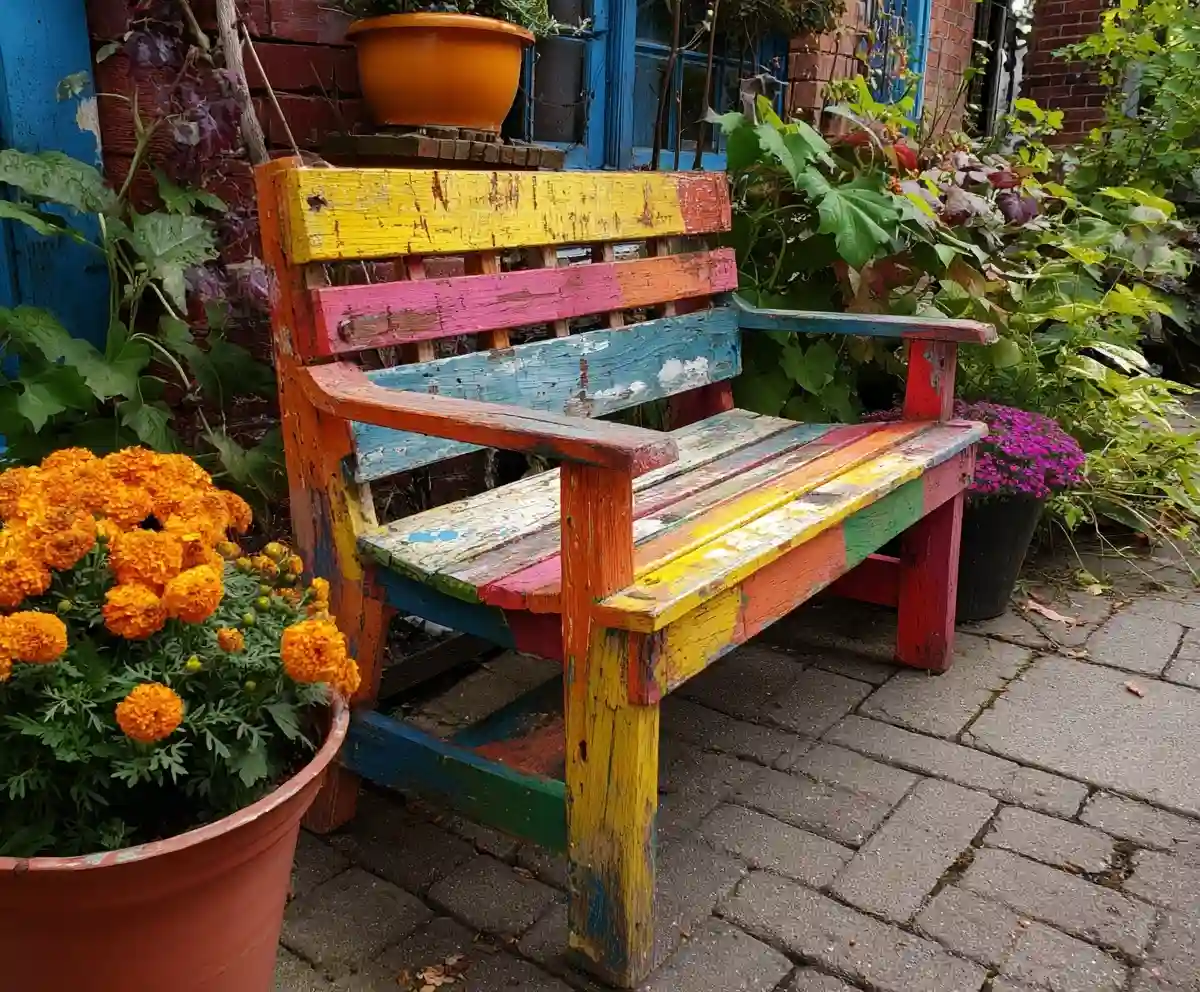
19+ Budget-Friendly Backyard Makeover Ideas
Backyard makeover ideas can turn even the most ordinary outdoor space into a warm, inviting retreat—without draining your wallet.
Read More →
21 Stunning & Simple DIY Clematis Trellis Designs
DIY clematis trellis designs are a beautiful way to blend creativity with function in your garden.
Read More →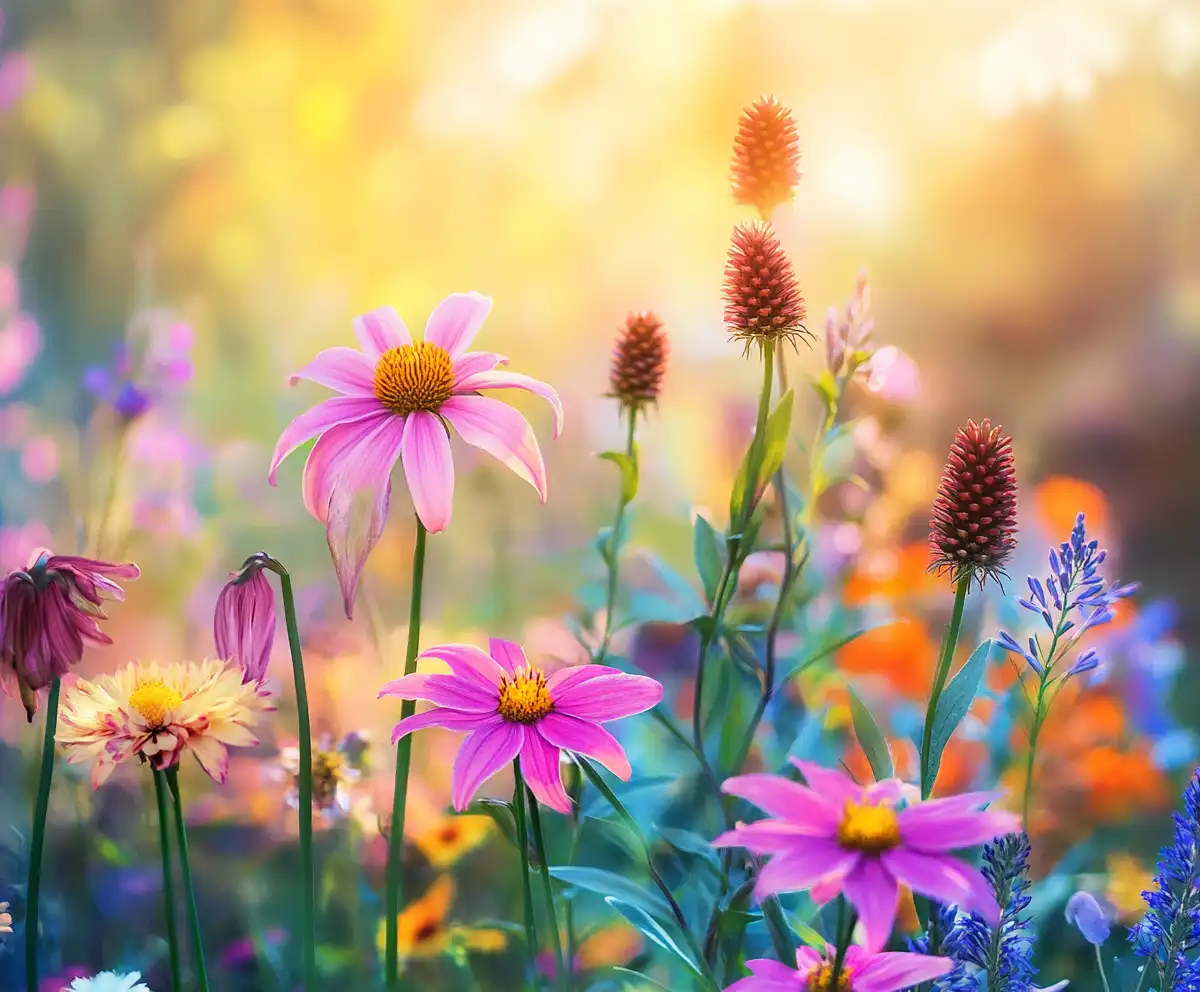
12 Full Sun Perennials That Bloom All Summer
Explore a selection of hardy perennials that flourish and bloom beautifully in full sun throughout the summer.
Read More →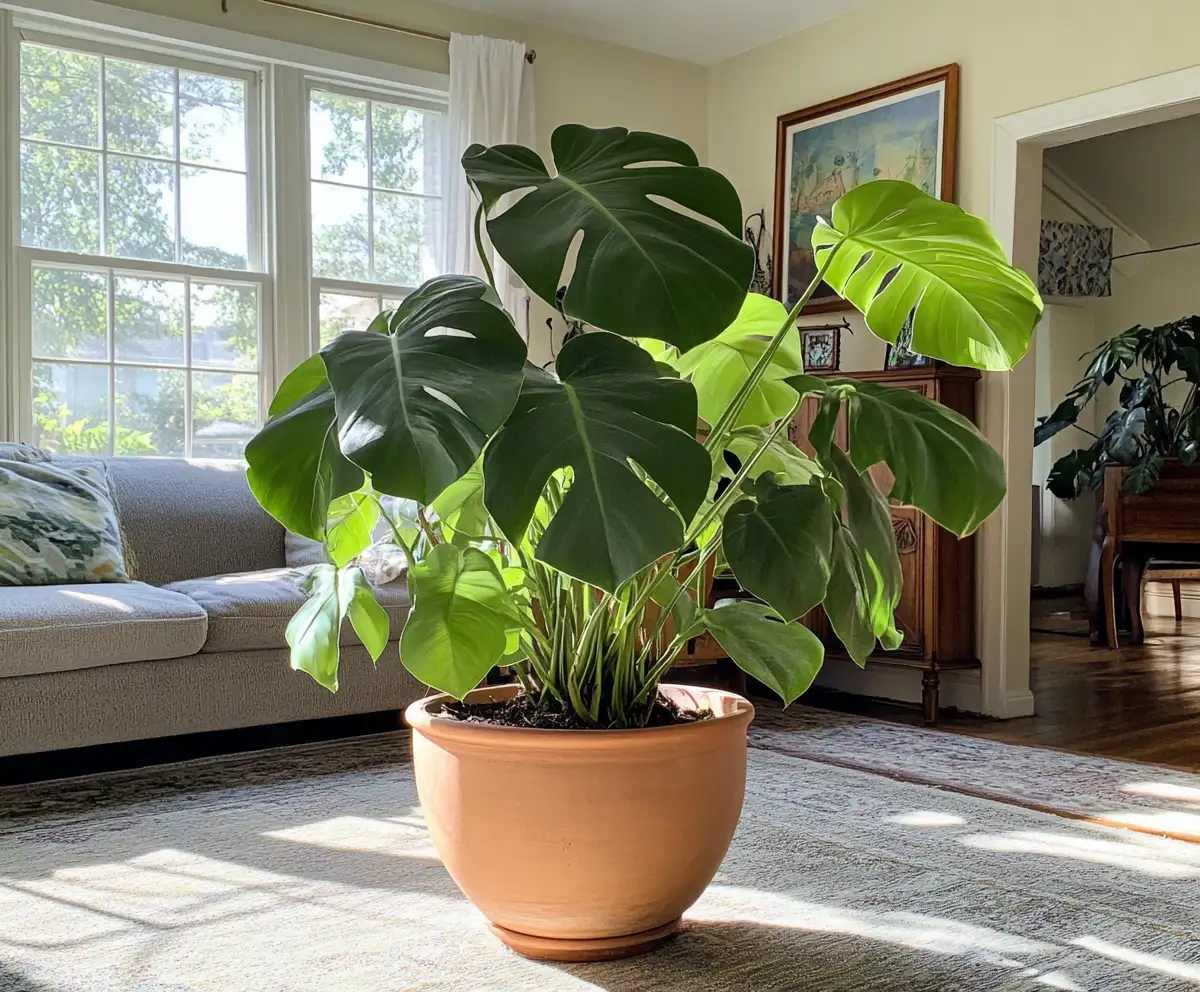
Houseplants for Living Room
Find the perfect houseplants to brighten and purify your living room while adding a touch of nature indoors.
Read More →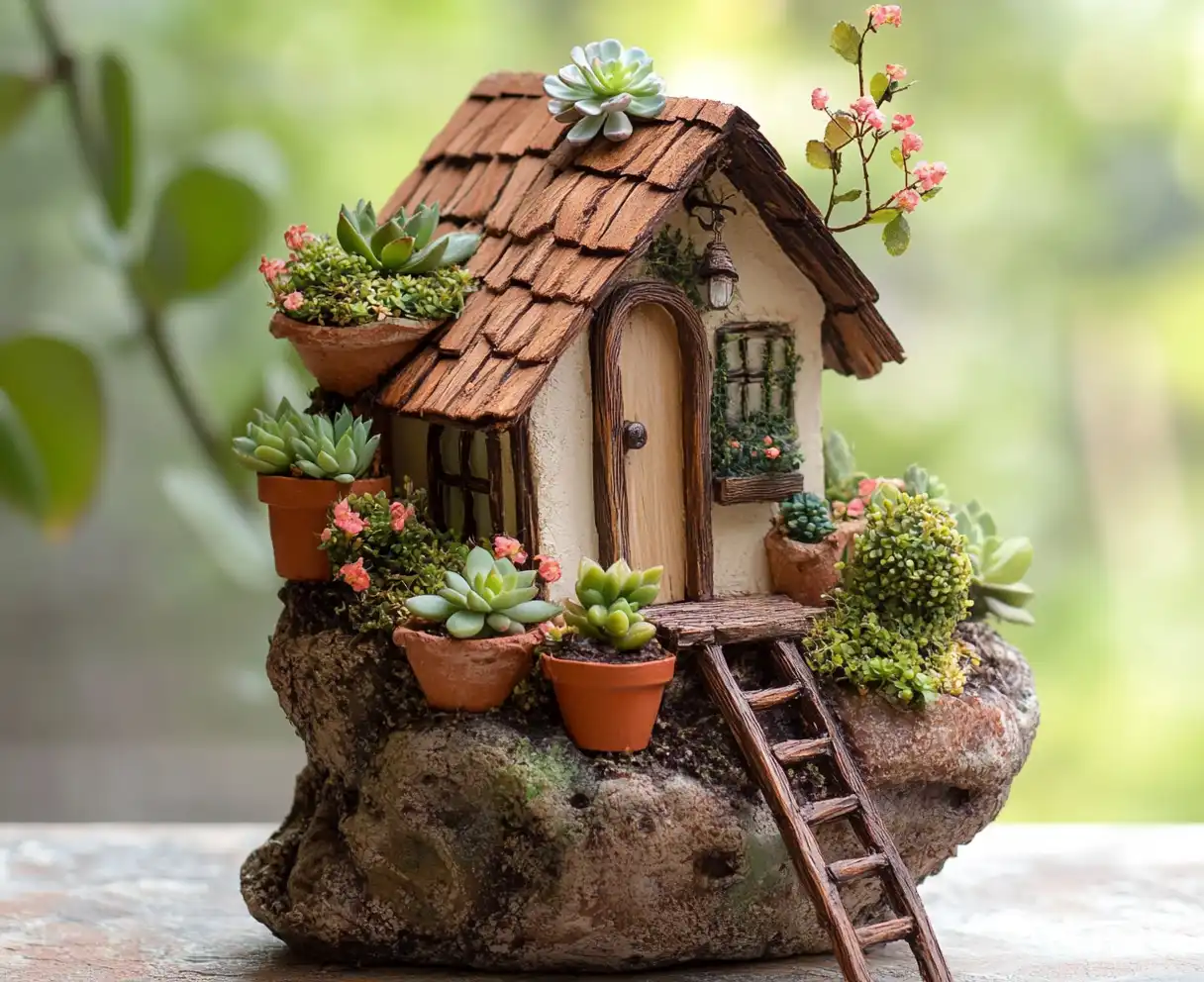
Backyard Play Area for Kids
Create a fun and safe backyard play area for kids with these inspiring design ideas and tips.
Read More →
Top Privacy Trees
Discover top tree varieties that provide natural privacy and enhance your outdoor space.
Read More →
